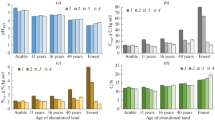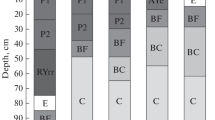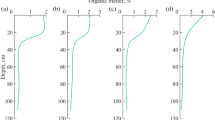Abstract
In Tuva, during the fallow succession on ordinary chernozem (Voronic Chernozem Pachic, WRB 2006) and chestnut soil (Haplic Kastanozem Chromic, WRB 2006), changes in the species composition of phytocenoses, total stock and structure of the phytomass, and net primary production were determined. It was found that the species composition of the zonal phytocenosis and humus stock characteristic of the virgin soils are restored first of all. The structure of belowground plant matter is restored most slowly. The first stage of the succession is characterized by the high stock of aboveground phytomass and low stock of belowground phytomass. During succession, the amount of aboveground phytomass decreases, while the amount of belowground phytomass increases. In 4–17 years, the total stock of plant matter in the ordinary chernozem and chestnut soil increases twofold and threefold, respectively, but does not reach the values typical of the reference zonal soils. In the same period, the net primary production increases by 1.5 times on the ordinary chernozem and 2.5 times on the chestnut soil. The net primary production is almost two times higher in the zonal steppes. The total net primary production (expressed in carbon) was calculated for 17 years of succession; it amounted to 67 and 49 t C/ha in the meadow steppe (chernozem) and dry steppe (chestnut soil), respectively. The total production is distributed as follows: its share spent for the accumulation of aboveground and belowground phytomass is equal in both ecosystems, whereas its share converted into humus is twice higher in the dry steppe with chestnut soil. The CO2 emission reaches 70–75% of the total production in both cases.


Similar content being viewed by others
REFERENCES
N. I. Bazilevich, Biological Productivity of Ecosystems of the Northern Eurasia (Nauka, Moscow, 1993) [in Russian].
N. I. Bazilevich, E. I. Shmakova, A. A. Tishkov, and Tran Ti, “Herbaceous ecosystems of the Russian Plain, Kursk oblast,” in Biological Productivity of Grasslands. Geographical Regularities and Ecological Features (Nauka, Novosibirsk, 1988), pp. 58–66.
E. F. Vedrova, Doctoral Dissertation in Biology (Krasnoyarsk, 2005).
A. M. Ermolaev and L. T. Shirshova, “Productivity and functions of a perennial sown meadow under different management practices,” Pochvovedenie, No. 12, 97–105 (1994).
I. V. Ivanov and Yu. G. Chendev, “History of the development of chernozems in the Central Chernozem Region and their modern humus profile,” in Proceedings of the Scientific Conf. Dedicated to the 100th Anniversary of Prof. N.I. Bazilevich “Geography of Productivity and Biogeochemical Cycle in Terrestrial Landscapes” (Institute of Geography, Russian Academy of Sciences, Moscow, 2010), pp. 67–77.
D. V. Karelin, D. I. Lyuri, S. V. Goryachkin, V. N. Lunin, and A. V. Kudikov, “Changes in the carbon dioxide emission from soils in the course of postagrogenic succession in the chernozems forest-steppe” Eurasian Soil Sci. 48, 1229–1241 (2015).
I. N. Kurganova and V. O. Lopes De Gerenyu, “The stock of organic carbon in soils of the Russian Federation: updated estimation in connection with land use changes,” Dokl. Biol. Sci. 426, 219–221 (2009).
V. O. Lopes De Gerenyu, I. N. Kurganova, A. M. Ermolaev, and Ya. V. Kuzyakov, “Dynamics of organic carbon pools during self-recovery of arable chernozems,” Agrokhimiya, No. 5, 5–12 (2009).
L. N. Magomedova, “Dry desert steppe of Dagestan,” in Biological Productivity of Grasslands. Geographical Regularities and Ecological Features (Nauka, Novosibirsk, 1988), pp. 15–25.
Analysis of Biological Cycle in Various Nature Zones, Ed. by A. A. Rode (Mysl’, Moscow, 1978) [in Russian].
N. P. Mironycheva-Tokareva, “Anthropogenic dynamics of steppe ecosystems of the Urals,” Vestn. Sib. Gos. Geodez. Akad., No. 11, 203–207 (2006).
A. V. Naumov, “Production-destructive link of the biotic cycle in a global aspect,” in Proceedings of the Scientific Conf. Dedicated to the 100th Anniversary of Prof. N.I. Bazilevich “Geography of Productivity and Biogeochemical Cycle in Terrestrial Landscapes” (Institute of Geography, Russian Academy of Sciences, Moscow, 2010), pp. 96–100.
Productivity of Herbaceous Ecosystems: Handbook (MBA, Moscow, 2020) [in Russian].
A. A. Romanovskaya, Doctoral Dissertation in Biology (Moscow, 2008).
I. M. Ryzhova, A. A. Erokhova, and M. A. Podvezennaya, “Dynamics of carbon pools in post-agrogenic ecosystems as a result of natural reforestation in Kostroma oblast,” Lesovedenie, No. 4, 307–317 (2015).
Dry Meadow as a Biogeocenosis (Nauka, Moscow, 1978) [in Russian].
A. A. Titlyanova, “Primary production and humus reserves in ecosystems,” in Problems of Soil Science in Siberia (Nauka, Novosibirsk, 1990), pp. 47–53.
A. A. Titlyanova and N. I. Bazilevich, “Functional model of metabolic processes,” in Structure, Functions, and Evolution of the System of Biogeocenosises of Baraba, Vol. 2: Biogeocenotic Processes (Nauka, Novosibirsk, 1976), pp. 449–467.
A. A. Titlyanova, G. I. Bulavko, S. Ya. Kudryashova, A. V. Naumov, V. V. Smirnov, and A. A. Tanasienko, “The reserves and losses of organic carbon in the soils of Siberia,” Eurasian Soil Sci. 31, 45–53 (1998).
A. A. Titlyanova and A. D. Sambuu, “Determinacy and synchronicity of fallow succession in the Tuva steppes,” Biol. Bull. (Moscow) 41, 545–553 (2014).
A. A. Titlyanova and A. D. Sambuu, Successions in Herbaceous Ecosystems (Siberian Branch, Russian Academy of Sciences, Novosibirsk, 2016) [in Russian].
O. V. Trefilova, E. F. Vedrova, and V. V. Kuz’michev, “Annual carbon cycle in green moss pine forests of the Yenisei Plain,” Lesovedenie, No. 1, 3–12 (2011).
M. M. Fartushina, “Productivity dynamics of associations of desert-steppe complex of the Northern Caspian region,” in Productivity of Hayfields and Pastures (Nauka, Novosibirsk, 1986), pp. 74–77.
C. Cerli, L. Celi, M.-B. Johansson, I. Kögel-Knabner, L. Rosenqvist, and E. Zanini, “Soil organic matter changes in a spruce chronosequence on Swedish former agricultural soil. I. Carbon and lignin dynamics,” Soil Sci. 171 (11), 837–849 (2006). https://doi.org/10.1097/01.ss.0000228061.23334.98
L. Deng, G. B. Liu, and Z. P. Shangguan, “Land-use conversion and changing soil carbon stocks in China’s ‘Grain-for-Green’ Program: a synthesis,” Global Change Biol. 20, 3544–3556 (2014).
I. Kukuļs, M. Kļaviņš, O. Nikodemus, R. Kasparinskis, and G. Brūmelis, “Changes in soil organic matter and soil humic substances following the afforestation of former agricultural lands in the boreal-nemoral ecotone (Latvia),” Geoderma Reg. 15, e00213 (2019).
J. Li, M. Li, L. Dong, K. Wang, Y. Liu, X. Hai, Y. Pan, W. Lv, X. Wang, Zh. Shangguan, and L. Deng, “Plant productivity and microbial composition drive soil carbon and nitrogen sequestrations following cropland abandonment,” Sci. Total Environ. 744, 140802 (2020). https://doi.org/10.1016/j.scitotenv.2020.140802
I. N. Kurganova, V. O. Lopes de Gerenyu, T. N. Myakshina, V. L. Lichko, and A. M. Yermolaev, “Changes in carbon stocks of former croplands in Russia,” Žemės Ūkio Mokslai 15 (4), 10–15 (2008.
I. Kurganova, V. Lopes de Gerenyu, and Y. Kuzyakov, “Large-scale carbon sequestration in post-agrogenic ecosystems in Russia and Kazakhstan,” Catena 133, 461–466 (2015). https://doi.org/10.1016/j.catena.2015.06.002
A. A. Larionova, A. M. Ermolaev, V. I. Nikitishen, V. O. Lopes de Gerenyu, and I. V. Evdokimov, “Carbon budget in arable gray forest soils under different land use conditions,” Eurasian Soil Sci. 42, 1364–1373 (2009).
T. Wang, F. F. Kang, X. Q. Cheng, H. R. Han, and W. J. Ji, “Soil organic carbon and total nitrogen stocks under different land uses in a hilly ecological restoration area of North China,” Soil Tillage Res. 163, 176–184 (2016).
ACKNOWLEDGMENTS
This study was carried out in agreement with the state assignment of the Institute of Soil Science and Agrochemistry, Siberian Branch of the Russian Academy of Sciences.
Author information
Authors and Affiliations
Corresponding author
Ethics declarations
The authors declare that they have no conflicts of interest.
Additional information
Translated by O. Eremina
Rights and permissions
About this article
Cite this article
Titlyanova, A.A., Shibareva, S.V. Change in the Net Primary Production and Carbon Stock Recovery in Fallow Soils. Eurasian Soil Sc. 55, 501–510 (2022). https://doi.org/10.1134/S1064229322040135
Received:
Revised:
Accepted:
Published:
Issue Date:
DOI: https://doi.org/10.1134/S1064229322040135




